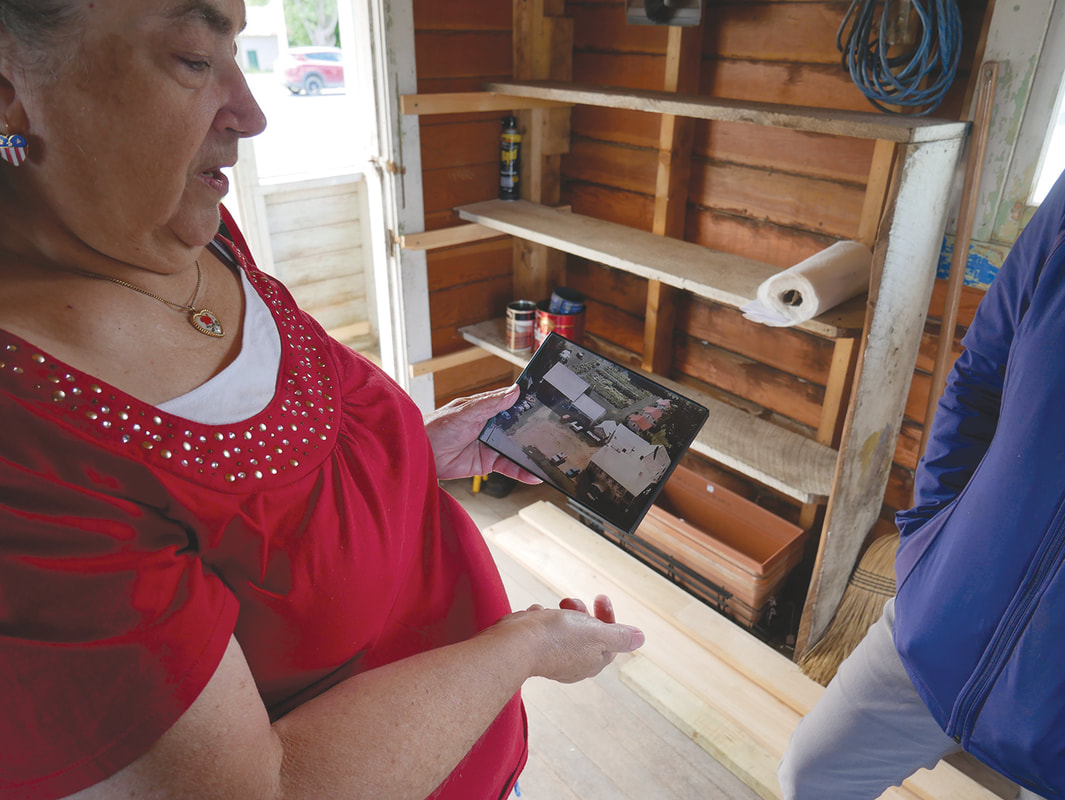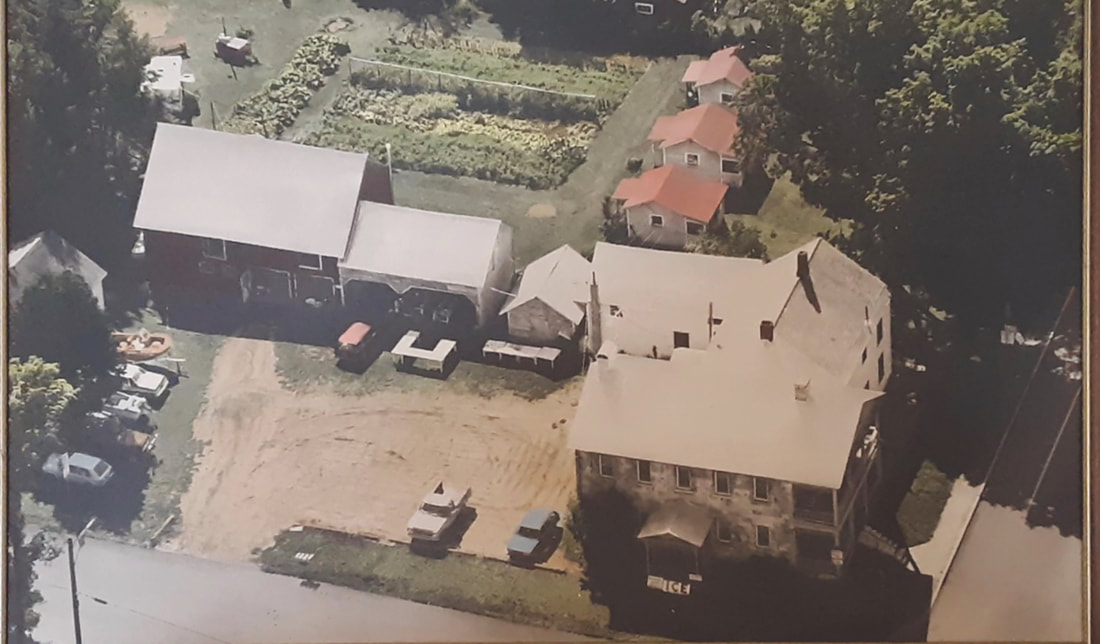From tourism to “Timstead”: Restoration recalls many lives of South Hero’s “Honeymoon Cabin”9/8/2021
By MICHAEL FRETT Islander Correspondent SOUTH HERO – The small cabin parked in South Hero’s village has had several lives, and while its early life is the stuff of local histories, its more recent history is one Colleen Bushway remembers personally. Her name was on it, after all. “The ABC Craft Shop stands for Anna, Betty and Colleen,” Bushway said, recalling a far more recent life for the cabin as a craft shop. “Anna was my mother, Betty is my sister and I’m Colleen.” Today the cabin sits idle near the South Hero Meeting House at the far end of a patch of green the South Hero Bicentennial Museum hopes to see converted into a parklet centered on the century-old cabin. Already museum officials have managed some restoration work with the help of volunteers and donations, stabilizing the cabin for its eventual facelift as a small museum. The dream, according to museum officials, is to see the cabin take the shape of the pre-electricity honeymoon suite it was designed as around the start of the 1900s, after the coming of the railroad heralded the arrival of tourism to the Champlain Islands. “Tourism was – and is – the way we make money in South Hero,” Teresa Robinson, the South Hero Bicentennial Museum’s president, said. “The history of South Hero is camps and summer people.” But while its next life as a museum will focus on the cabin’s historic role as an extension of the inn now housing South Hero’s Community Bank extension, more than just newlyweds will be remembered with this small cabin’s restoration. Honeymooners The “Honeymoon Cabin” was built more than a century ago as a honeymoon suite for the South Hero Inn, the centuries-old stone building now housing Community Bank’s South Hero branch. At the time, the inn had been a temporary home for travelers passing through South Hero on their way toward Montreal and New York’s North Country, one of many in the island’s history with only modest accommodations for traveling traders and farmers passing through. As the arrival of the railroad tied the Champlain Islands more directly to Burlington, however, a new kind of visitor arrived in the islands, and Lillian Axtell, the owner of what would be renamed the South Hero Inn, hoped to cash in on the coming tourism economy that still defines island life today. Axtell had three modestly furnished vacation cabins built behind the inn, offering a private getaway for newlyweds who might otherwise chafe at the idea of staying in the far less private inn. For decades, the eventually electrified cabins provided visitors with romantic stays in the Champlain Island, becoming token examples of an increasingly visitor-centered economy before ultimately succumbing to disrepair sometime in the middle of the century. By the time Bushway’s family came to own the inn in the 1970s, the South Hero Inn had been foreclosed and all three of the inn’s honeymoon cabins had become disheveled shadows of a romantic past. The ABCs of a craft store Colleen Bushway grew up as Colleen Poquette in Winooski, where her mother worked in a sewing factory and also made alterations for local families. “I actually have a photo of the sign in Winooski that says ‘alterations’ and everything,” Bushway said. But after coming to own a camp in South Hero’s “Shadowland,” Bushway’s parents purchased the South Hero Inn and began operating the waystation in the 1970s, becoming fulltime islanders in the process. According to Bushway, her family’s purchase of the inn was entirely a “family affair.” The Poquette family’s savings went to making a down payment on the inn and, with Bushway herself finishing up with college, she joined three of the four other Poquette children and moved into the South Hero Inn. “My father wanted to keep the five of us kids together,” Bushway said. “We cleaned up there. We served people. We cooked. The boys played music in the band.” When they took over the then-foreclosed inn, the Poquette family also inherited a trio of ramshackle cabins that had been let to rot behind the historic inn. According to Bushway, the cabins had been neglected for some time, though for exactly how long had been a mystery even then. Regardless, time had clearly taken a toll on the three buildings, one of which had become a junk shed and another of which would be demoted to being the Poquettes’ greenhouse. The middle shed, however, remained in decent enough shape that, with a few repairs, the Poquettes managed to reopen it as a small craft shop, the only one at the time in South Hero. “My father was the one who put that plywood up there,” Bushway said, pointing to a few leftover repairs. The ABC Craft Shop, named for Bushway, her mother and her sister, provided supplies for sewing and crafting visitors and residents would otherwise need to travel to Burlington or Essex to buy. In turn, the shop was a source of supplemental income for the Poquettes, who made a living off the nearby inn. It was also fulfilling a sort of dream for Bushway’s mother, who had always dreamed of having their own craft store. “I wouldn’t say it made her a lot of money, but it satisfied that need in her,” Bushway said. “She always wanted to have her own craft shop.” Eventually the South Hero Inn would close again, becoming apartments by the 1980s and, by the 1990s, home to the local branch of a regional bank. Bushway, who recalls living upstairs in the stone segment of the inn still looming over Route 2, married into the Bushway family and moved into Grand Isle. From “Timstead” to time machine According to the South Hero Bicentennial Museum, at around the time the bank purchased the South Hero Inn, the inn’s accompanying cabins were moved off the property. One of those found its way to “Timstead,” an area farm managed by Tim Maxham. On the farm, the cabin took on another life, becoming the playhouse for the Maxham family’s children. On the inside face of the cabin’s front door, a collage of children’s handprints and footprints against a white backdrop frame the names of the Maxham family’s children, a detail the South Hero Bicentennial Museum intends to preserve even as the rest of the cabin takes on a more historic appearance. Years later, the cabin would be donated to the museum on the condition the museum removed the cabin from “Timstead.” Because the museum itself lacked the room on its property for a cabin, South Hero’s selectboard allowed the cabin take up residence near the South Hero Meeting House. Today, the cabin shows some signs of a restoration project already well underway. Robinson told The Islander she sees the museum easily being able to restore the cabin within the coming years, with the dreams of a historical marker outside describing the cabin’s association with the nearby South Hero Inn. The cabin’s association with the inn is what museum officials and volunteers, including Bushway herself, hope to especially emphasize as the cabin’s interior is restored to look like the honeymoon suites Axtell sought when she rechristened the Island House as the South Hero Inn more than a century ago. “It’s part of the South Hero Inn’s history and that is the most important building in town,” Cathie Merrihew, the museum’s treasurer, said of the museum’s plans for the cabin. “I don’t think South Hero has very many buildings that still evoke an era.” Museum officials who met with The Islander talked about dressing the cabin’s interior with historic furniture from the time, some of its sourced locally within South Hero itself. Already an appropriate kerosene lamp was available for the future Honeymoon Cabin museum. Still, pieces recalling a larger story will be visible inside, remembering the years when a cabin was left in disrepair, only to see new life as South Hero’s only craft shop and, after that, the playground for children from a local family whose names still grace the building’s front door. Bushway, meanwhile, looks forward to seeing a restored cabin open to the public. The self-described history buff, now a volunteer with Grand Isle’s historical society and an active participant in the Honeymoon Cabin’s restoration in South Hero, wants the cabin’s history shared. “I want people to really care about the past and learn from it, enjoy it and know it,” Bushway said. There were personal reasons for her support, as well. When she met with The Islander last week, Bushway brought with her an aerial photo of the South Hero Inn that included its now demolished stable barn and its three rustic cabins, of which only the museum’s still stands. “I would like it that my granddaughter could come in here and see what life was like,” Bushway said. “I want to be able to say to my grandkids: ‘You see this picture? This is where your great-grandma and grandpa lived, this is where I lived.’” Comments are closed.
|
© 2024 The Islander. All rights reserved.





 RSS Feed
RSS Feed